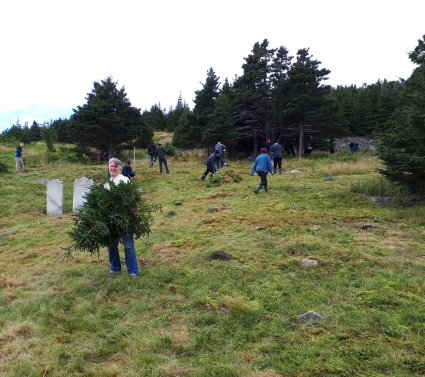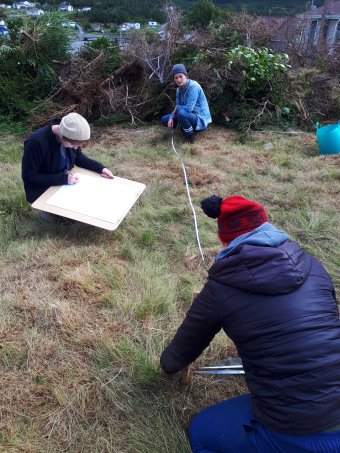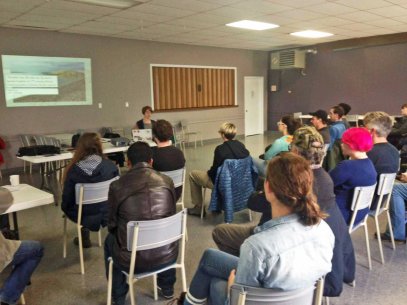This Saturday I was invited to speak at and participate in a community heritage & folklore event in the town of New Perlican, Newfoundland. New Perlican is located on the eastern coast of the Avalon Peninsula, and has dated back to the 17th-century through records such as the 1675 Berry Census and archaeological evidence of a ‘plantation’ in the area. It is suspected that several of John Guy’s settlers from the 1610 Cupid’s Plantation may have settled in New Perlican in the early 17th century, but there has yet to be any physical evidence of that move identified.
The event I was involved with was a collaboration between the Heritage Foundation of Newfoundland and Labrador, Memorial University of Newfoundland, and Heritage New Perlican, and involved something really that I’m pretty passionate about…burial grounds! Students and community volunteers would join us for the day to learn about the history burial places in this historic town, hear about the town’s history from members of the Heritage group, meet the cemetery cleaning ‘Goats of New Perlican’, and help the community clean up one of their most historic burial spaces. I was there as an additional help supervising the students, to answer questions on burials and gravestones (and have some awesome conversations about headstone preservation with local folks!), and to give a talk about my research as a historic mortuary archaeologist. Also, to map a bunch of gravestones!
 We started out the day by meeting the folks from Heritage New Perlican, and bringing all of our gear over to the burial ground. Yes, I am going to be referring to it as a burial ground. St. Mark’s Anglican Cemetery, as it is commonly known, is one of the older known burial sites in the community. We were told it used to have a church associated with the site directly, but no one living or in the past few generations was alive to see that church so the exact location of it is still unknown. Due to the likelyhood of the site being older than the 19th-century, cemetery is an imprecise word choice and until we known through archaeological or documentary evidence that a church was on the site as well, burial ground is the best term to refer to the nature of the site itself, at least when not using its name, which does include the word ‘Cemetery’.
We started out the day by meeting the folks from Heritage New Perlican, and bringing all of our gear over to the burial ground. Yes, I am going to be referring to it as a burial ground. St. Mark’s Anglican Cemetery, as it is commonly known, is one of the older known burial sites in the community. We were told it used to have a church associated with the site directly, but no one living or in the past few generations was alive to see that church so the exact location of it is still unknown. Due to the likelyhood of the site being older than the 19th-century, cemetery is an imprecise word choice and until we known through archaeological or documentary evidence that a church was on the site as well, burial ground is the best term to refer to the nature of the site itself, at least when not using its name, which does include the word ‘Cemetery’.

Dale Jarvis, Intangible Cultural Heritage Development Officer for NL, addressing the group on site, Sept. 30th, 2017.
This was a joint project with student, professionals, and community members. It’s really exciting to work on a project that involves so many people from so many different areas of expertise! It’s also great to see so many people in the town interested in not only protecting their heritage and cleaning up an old burial site, but in learned how and why archaeologists record things as we do, and how they can work to better preserve the gravestones and the site itself. For this survey day, we obtained an archaeological research permit, which allows only surface inspection of the site. This is because unlike a more modern burial site, St. Mark’s has been closed for many years, making it a heritage site within the province. The community expressed interest in probing the ground with metal spikes to look for buried gravestones, but because a research permit was required to begin the surveying project, that meant an excavation permit would be required to do anything subsurface. I believe that this project is going to be a long-term collaboration, so an excavation permit to recover headstones probably wouldn’t be out of the question one day…but for that time being, we stuck to the surface clearing of debris and brush, and recording of some of the gravestones.

Everyone was pitching in to clear the massive burial ground!
It was a typical Newfoundland fall day (finally), crisp air, sometimes sunny sometimes overcast, with a breeze coming up from the peaceful harbour below. Basically what you see in those tourism commercials, but everyone involved was standing between rows of graves, instead of hiking the East Coast Trail. The students who joined us were a mixture of archaeology graduate and undergraduates, folklore, sociology, history, business, and anthropology students, all interested in learning about historic burial grounds and about the symbology and meaning behind many of the carvings on gravestones. The first task of the day was to get everyone helping to clear the burial ground! Gloves were handed out, and members of Heritage New Perlican were already on site clearing brush and cutting down trees by the time we arrived! I took a run around to look for locally carved headstones (which I’ll talk about in a bit), before gathering a few archaeology students to start the survey of the site.

Myself, and undergrad arch students Kate and Hailey starting the survey plan of the gravestones. Photo by Shannon Lewis-Simpson
What we all assumed when we arrived at St. Mark’s was that the burial ground was many 15m x 20m, not too big. This assumption was based on what we could already see had been cleared, and I thought we might be able to get it mapped in an afternoon. However, if you look at the photo above, you’ll notice people going up into the trees…because the graves went all the way up there as well. The site was more like 50m x 40m, and would definitely not be finished in one afternoon, but we had to make a start somewhere! I laid out a tape along the southeast side of the site as a starting point, and had my little team on either end of another tape to tell me how far along the datum line we were, and how far up the gravestone was. (of course I forgot my reading glasses so counting the 1mm grid paper was pretty difficult!).
By the end of the afternoon we had recorded the locations of 58 gravestones. That might seem like a lot, but in actuality it made up less than 1/4 of the site as a whole. There are already plans in the works to go back and finish the record. What would be ideal is to get more students and community members who are interested in surveying the gravestones themselves that we can teach the recording forms to. Once the plan is established all of the stones will have designated numbers, and by putting that on the recording forms for the gravestones as well, it’s easy to quickly find the stone on the plan and in the burial ground!
Below is an image of the stones (both head and foot stones) that were mapped during this lovely day spent at the St. Mark’s Anglican Cemetery. The exercise of mapping a burial ground is extremely important for all aspects of field archaeology, as top-down mapping is used in excavation plans as well. It also helps give us a better understanding of how the burials themselves are laid out within the confines (or not) of the burial ground itself.

Can you see the rows? They aren’t as clear on the ground, but really jump out once the stones are recorded on a map!
The lovely people of New Perlican put on a lunch for the students in their town hall / community centre, so after a while of working outside we were all invited to come back to the hall and have some food. This is the main event that I was invited out for: a lunch time lecture! This was the first time got to talk about the results of my entire thesis project since it has been officially completed, so I was nervous per usual but also pretty excited to share some of my results with such a lovely group of people. I talked about my exploration of spatial organization of burial landscapes in Newfoundland and New England, and what that can tell us about Ferryland and potentially other sites in the province as well!

Starting my talk! Photo by Shannon Lewis-Simpson.
After lunch, we split up into two grounds: People who wanted to help myself and Shannon map and record gravestones at the historic site, and people who wanted to go pet goats and learn about symbology on gravestones from Dale. Most people went with Dale…and I would have too if I didn’t have a load of mapping to try and finish before we had to leave! Back to the burial ground we went, and with the help of local volunteers managed to get a large amount of the debris from tree-clearing shifted out of the way, while also getting the first 20 or so gravestones recorded on both the map and on individual recording forms by dedicated graduate students. All in all, it was an amazing day getting to work in and experience an outport town that I’d not visited before, and to share a bit of my research and passion for historic burial grounds with a group of interested and lovely people!
I would consider this event, in some ways, as a bit of a community mortuary archaeology project. Heritage New Perlican members were on site, asking us as archaeologists and heritage professionals, the best way to proceed with the preservation and protection of the site and of the gravestones themselves. A lot of practices which were once considered commonplace, such as putting cornstarch on a gravestone, taking rubbings, or propping up old gravestones, all which sound fairly innocuous, have been determined as damaging to the stones in the long run, so it was great to have conversations with the community on site about how these things could do long term damage to the heritage site, and ways to promote the preservation of the stones for the future. I’m excited to return to record more of the stones in the near future, it was such a fun opportunity!
One thing I was really interested to keep my eyes peeled for at St. Mark’s was locally carved gravestones. I’m interested in the way that scripts developed within a fairly closed off society, perhaps without direct access to the latest print books from New England or the British Isles, which were often used as the standard for gravestone inscriptions and dictated the trends we see between the decades or centuries. St. Mark’s did not disappoint, and there were at least 3 stones carved from local slate with inscriptions on them!
Made from local stones, there grave markers were likely either carved in a nearby community to New Perlican. Records showed that there were slate cutters from Wales in Newfoundland dating back centuries, brought over to work the slate that the British were already aware was present on the island. It makes sense that a gravestone carving culture would spring up from that, and I’m not surprised to see these samples at the site! My favourite is the little red stone that reads ‘S W’ in uneven, capital letters. In addition to these, there were several headstones carved by A. Smith, a gravestone carver from St. John’s who was the first to import marble from New England for gravestones in the early 1800s, and MacKim, another carver from St. John’s who also worked with imported marble and limestone. Stones from professional gravestone cutters would have been very expensive for people living in outports in most cases, so seeing stones cut from local stones for those who couldn’t afford or didn’t want to purchase something more ornate and expensive is a really nice thing to see, and also indicates that the community believed it was important to have a marker of some sort regardless of how much you could pay for one.
I’m looking forward to getting back out there and completing the map, hopefully in the near future, so Heritage New Perlican can have a record of all the historic gravestones that sit in one of their oldest burial sites. I’d like to thank them for hosting us, and to Dale and Shannon for inviting me out for this awesome community event!

These are the ‘Goats of New Perlican’, who clean up one of the more modern burial grounds! Photo by Tasha Miller.




October 1, 2017 at 8:25 pm
We (Heritage New Perlican) were so pleased with the work accomplished yesterday! and so thankful for all the help that you, the Students, Shannon and Dale provided us. I have to say several years ago when we began this clean up never did I think we would uncover that many stones; that the graveyard was to be so big and that we’d find out that we didn’t have a clue what we were doing! We have come a long way and now I cannot wait to get the mapping and recording done of each headstone we can find there. Listening to the stories that graveyards were (in that time) built overlooking the harbour, one can just imagine how the people of the day must have felt to be burying their loved ones on a such a scenic spot! I believe the ancestors would be very proud not to be overlooked anymore and to take their rightful place in recorded history! Thank you all!
LikeLiked by 2 people
October 2, 2017 at 11:23 am
It really was an amazing site, and I’m happy to have gotten a chance to come out to meet all of you as well! It looks like there is more mapping in the near future too, so we’ll know how many stones you have. The site is so much bigger than I expected, it’s really lovely, and I’m looking forward to coming back out. 🙂
LikeLike
October 3, 2017 at 7:26 am
Reblogged this on sonofbluerobot.
LikeLike
October 6, 2017 at 2:54 pm
Hurray , can’t wait to get you and whoever else out to get at this again! Keep in touch Robyn, don’t forget to join our Heritage New Perlican FB group………so you can keep up on our activities!
LikeLiked by 1 person
October 8, 2017 at 1:11 pm
I’m hoping we can come back soon, and I’ll definitely join the fb group!
LikeLike
Pingback: Canadian History Roundup – Week of October 1, 2017 | Unwritten Histories
Pingback: Site Visit to Bloody Point, New Perlican, NL | Spade & the Grave